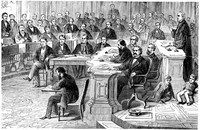Login form
Congress of the United States

For many people, the Capitol building in Washington, D.C., is a symbol of American democracy. With its huge dome, the Capitol stands on Capitol Hill and is where the United States Congress meets. But what exactly is Congress? What does Congress do?
WHAT IS THE UNITED STATES CONGRESS?
The United States government has three branches—a legislative branch, an executive branch, and a judicial branch. Congress is the legislative branch. Its main job is to make the nation’s laws.
Voters in different states elect the members of Congress. Each of the members represents many citizens. Members of Congress try to learn the views of the citizens they represent. They try to make laws that reflect the citizens’ wishes.
WHAT DOES CONGRESS DO?
The most important task of Congress is to make laws. But it has many other duties as well. Congress decides what taxes shall be collected and how government money will be spent. It sets rules for trade between the different states. Only Congress can order the printing of money or declare war.
HOW IS CONGRESS ORGANIZED?
The Congress itself has two parts. One is called the Senate. The other is the House of Representatives.
THE SENATE
The Senate has 100 members, called senators. Each state, big or small, elects two senators. Senators are elected for six-year terms.
The Senate has several special powers not shared by the House of Representatives. The Senate must approve all high officials appointed by the president. These officials include federal judges, diplomats, and members of the president’s Cabinet. Treaties with other countries need Senate approval, too.
THE HOUSE OF REPRESENTATIVES
The House of Representatives has 435 members. Every state has at least one representative. States with more people have more representatives. Members of the House are elected for two-year terms.
The House of Representatives has a leader called the Speaker of the House. The Speaker has great power. The Speaker decides what the House will discuss and who may speak next in a discussion. The Speaker also decides which representatives will work on which problems.
The House also has several unique powers. The most important one involves taxes. All laws having to do with taxes must start in the House.
In addition, if there is no clear winner in a presidential election, the House of Representatives is supposed to choose the winner. This is how Rutherford B. Hayes became president in 1876.
HOW DOES CONGRESS MAKE LAWS?
Any member of Congress can suggest a new law. This is called a bill. Other members of Congress then discuss the bill and vote on it.
When a bill is being discussed, members of Congress may change it or add to it. If a senator suggests a bill, the Senate discusses it first. If a representative suggests a bill, the House discusses it first. Either way, both parts of Congress must vote to approve a bill before it can move forward.
After both parts of Congress have accepted a bill, it goes to the president. If the president signs it, the bill becomes law.
The president may decide to veto, or reject, a bill. Then the bill goes back to Congress. If two-thirds of Congress votes for the bill, it becomes a law no matter what the president thinks. But the president’s veto is usually the end of the bill.
WHAT IS IMPEACHMENT?
If the president is accused of a serious crime, Congress can bring charges against the president. This is called impeachment.
The House of Representatives draws up the charges. Representatives can impeach the president if a majority in the House vote to do so. The Senate then sits as a court to hear the charges. Afterward, the Senate may vote to remove the president from office.
Congress has never removed a president from office. It did impeach President Andrew Johnson in 1868. Johnson kept his job by one vote in the Senate. Congress investigated President Richard Nixon for possible crimes in 1974. Nixon resigned before he could be impeached.
In 1998, President Clinton was impeached in the House. But he won his trial in the Senate and kept his job.
Source: Microsoft ® Encarta

